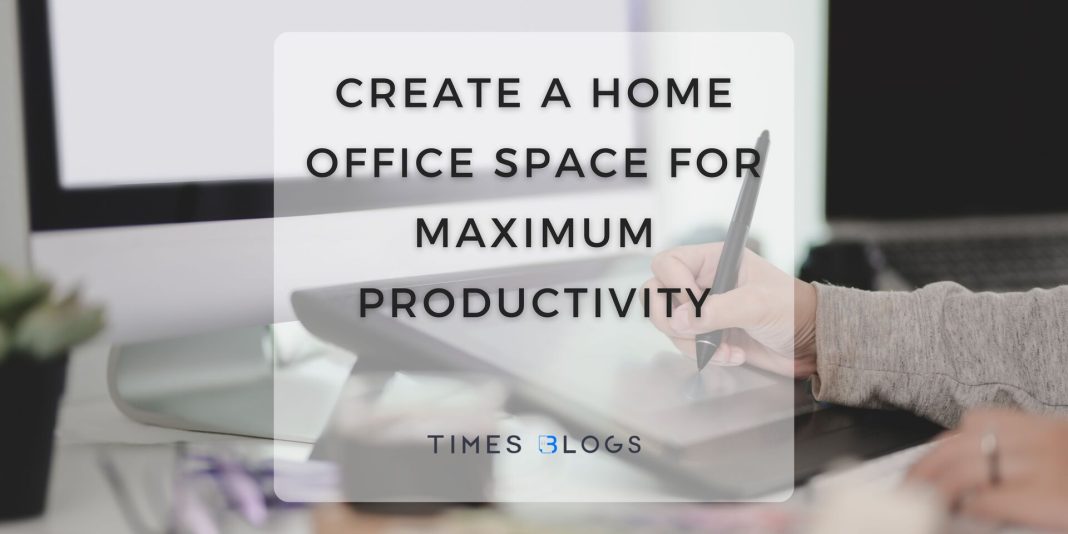Working from home has become increasingly popular over the past few years, and the need for a productive home office space has become more important than ever. Whether you work for a company remotely or run your own business, having a dedicated workspace can significantly impact your productivity and success. Creating an efficient home office space that is comfortable, organized, and tailored to your needs can make all the difference in your workday. In this blog post, we will explore ten tips on how to create a home office space for maximum productivity.
Table of Contents
Identify the Best Location for Your Home Office
The first step in creating a productive home office is choosing the right location. Ideally, your home office should be in a quiet and private area of your home where you can concentrate without interruptions.
Consider the amount of natural light and ventilation in the room, as well as the availability of electrical outlets and internet connectivity. A dedicated room or space can help create a sense of separation between work and personal life. However, if you don’t have a spare room, consider creating a workspace in a corner of another room, such as a bedroom or living room.
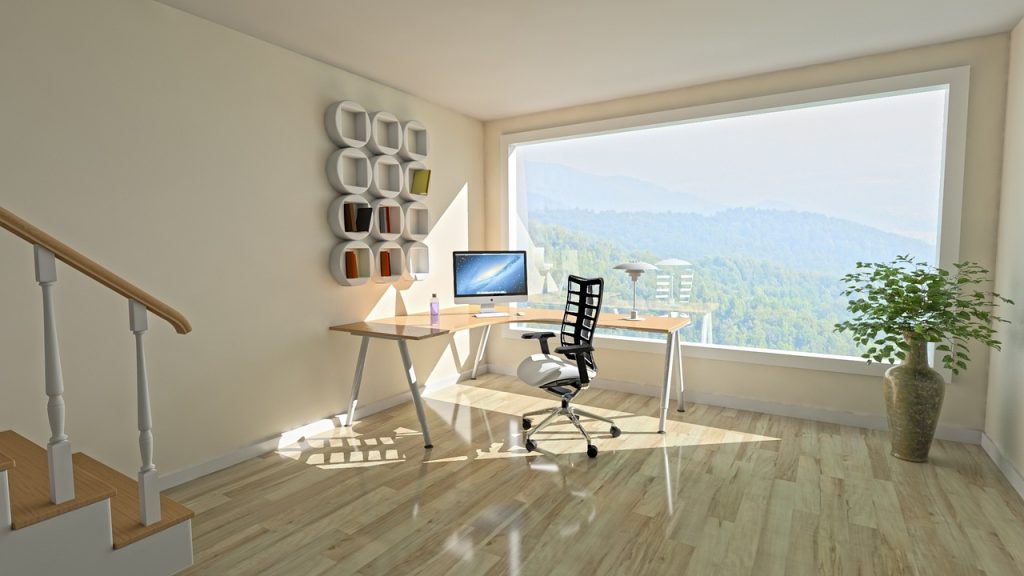
When selecting a location, also think about the layout and functionality of the space. Make sure you have enough room for a desk and chair, as well as any storage or organization tools you may need. Keep in mind any potential distractions, such as noise from a nearby street or family members. By choosing a location that supports your productivity and comfort, you can set yourself up for success in your work-from-home journey.
Choose the Right Desk and Chair
Investing in a comfortable and ergonomic desk and chair is crucial for maintaining good posture and preventing back pain. When selecting a desk, make sure it has enough space for your computer, paperwork, and other necessary items. A standing desk is also an excellent option for those who prefer to stand while working.
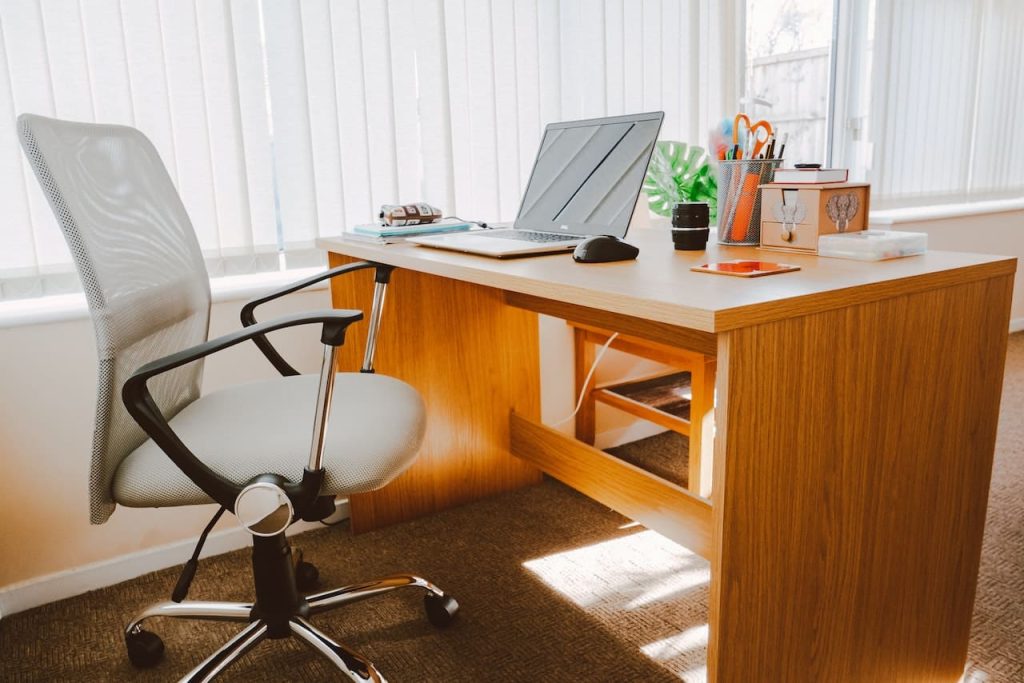
Similarly, your chair should be adjustable, with a comfortable seat and backrest. Ideally, the chair’s height should be adjustable so that you can set it to the correct height for your desk. When sitting in your chair, your feet should be flat on the floor, and your arms should be parallel to the desk.
Get Proper Lighting
Lighting is an essential factor in creating a productive home office. Natural light is ideal, as it provides a boost of energy and can improve your mood. Position your desk near a window to take advantage of natural light, and consider investing in window treatments to reduce glare on your computer screen.
In addition to natural light, you’ll also need adequate artificial lighting. A desk lamp is essential for illuminating your workspace, and overhead lighting can help brighten up the room. Make sure your lighting is bright enough to prevent eye strain but not so bright that it causes glare on your computer screen.
Organize Your Workspace
A cluttered workspace can negatively impact your productivity and focus. Taking the time to organize your workspace can help you stay on track and minimize distractions.
Start by decluttering your workspace and getting rid of anything that you don’t need or use regularly. This could include old papers, broken equipment, or unnecessary decorations. Use storage solutions like shelves, drawers, and filing cabinets to keep your essentials organized and easily accessible.
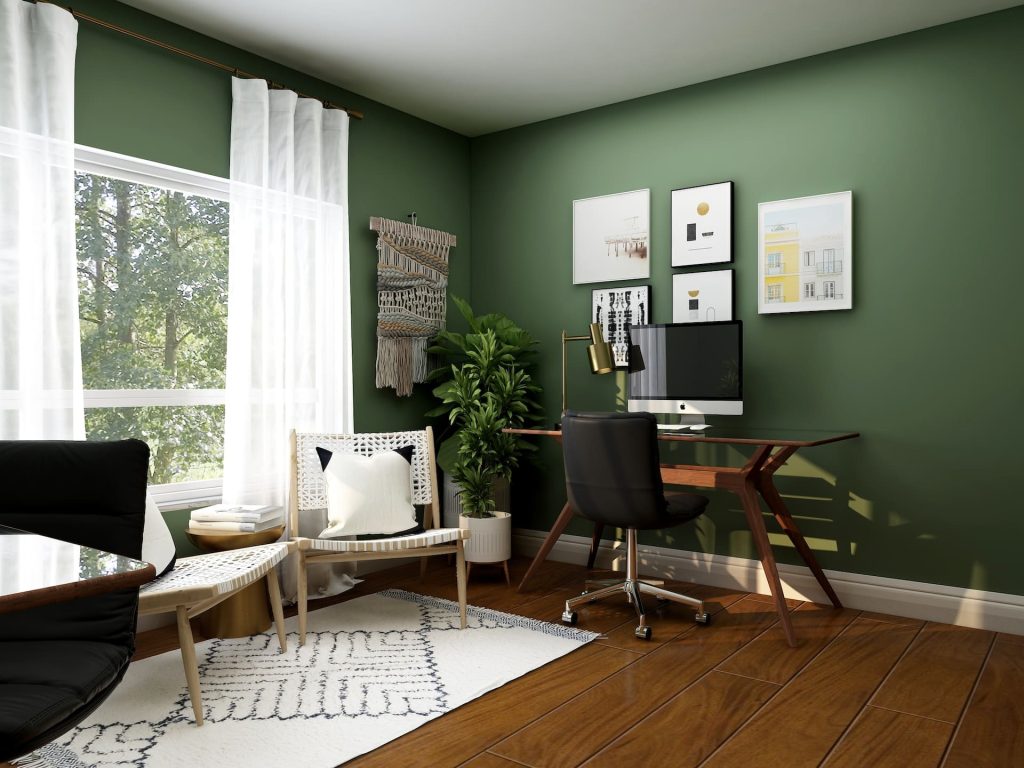
Labeling your files and folders can also help you find what you need quickly and efficiently. Invest in a good label maker or use sticky notes to create clear and consistent labels.
Additionally, make sure your desk and workspace are clean and free of dust or debris. Regularly wipe down surfaces and equipment to prevent the buildup of germs and bacteria.
Add Personal Touches
While it’s important to keep your workspace organized and clutter-free, adding personal touches can also help make your home office feel like your own.
Consider adding decor, such as plants, photos, or artwork, that inspires you and reflects your personality. This can help create a positive and motivating atmosphere that enhances your creativity and productivity.
You can also add functional touches, such as a comfortable chair or a cozy rug, that make your workspace comfortable and inviting. Invest in high-quality lighting solutions, like desk lamps or floor lamps, to ensure your workspace is well-lit and promotes alertness and focus.

Personalizing your workspace can also help you differentiate between work and home life. By creating a designated workspace that feels distinct from the rest of your home, you can help establish a boundary between work and leisure time. This can help you maintain a healthy work-life balance and avoid burnout.
Invest in Technology
Investing in technology can help you work more efficiently and effectively in your home office. Consider the tools and software that can help you streamline your workflow and improve your productivity.
For example, investing in a high-quality computer, printer, and scanner can help you stay organized and work more efficiently. Consider software solutions that can help you manage your to-do list, track your time, or collaborate with others remotely. Video conferencing tools like Zoom or Skype can also be valuable for staying connected with clients or colleagues.
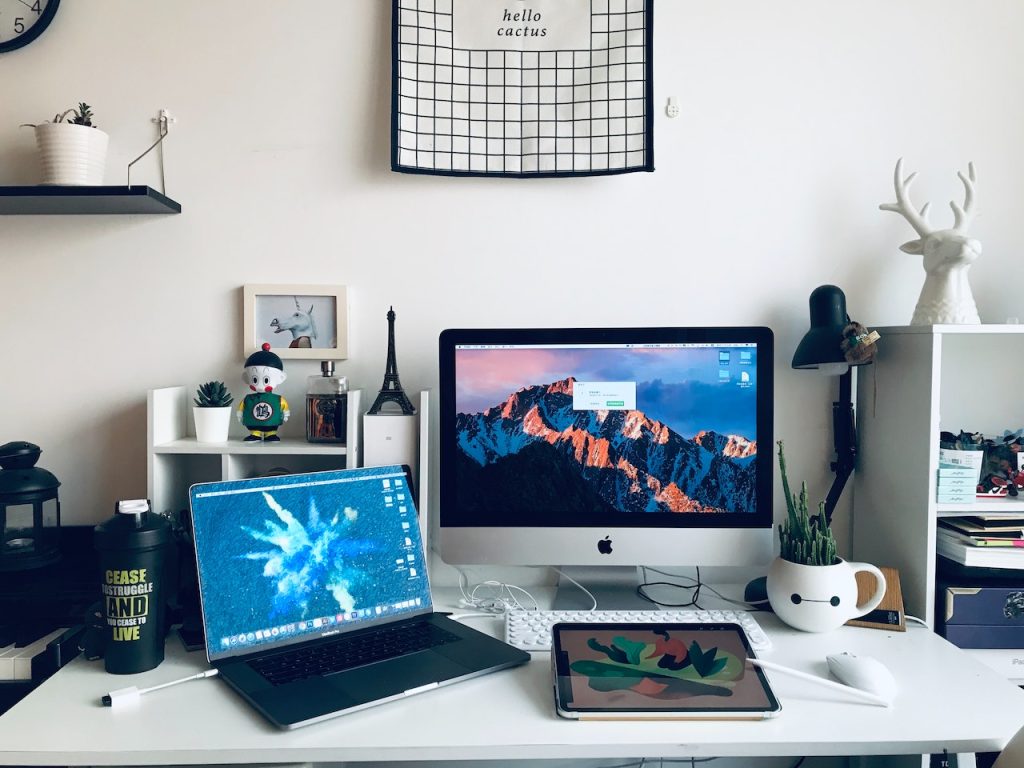
It’s also essential to invest in cybersecurity measures to protect your sensitive information and data. Consider using a reputable antivirus program and regularly backing up your files to prevent data loss.
Set Boundaries
When working from home, it can be challenging to separate your work life from your personal life. Setting boundaries can help you create a healthy balance and maintain your well-being.
Start by setting clear work hours and sticking to them. Communicate your availability to your colleagues, clients, or family members to avoid interruptions or conflicts. Set specific goals or tasks for each day and prioritize your time accordingly. Avoid multitasking or working beyond your work hours, as this can lead to burnout and stress.
It’s also important to set physical boundaries and create a dedicated workspace. Communicate with your family members or roommates about your need for privacy and quiet during work hours. Use noise-canceling headphones or a “do not disturb” sign to minimize interruptions. When you’re done with work, make sure to physically leave your workspace and take a break to recharge and refresh your mind.
Personalize Your Space
Personalizing your workspace can help you feel more connected and motivated in your work. It’s important to create a space that you enjoy spending time in and that reflects your personality and style.
Consider adding decor or artwork that inspires you or reflects your interests. This could include motivational quotes, photos of loved ones, or artwork that you find inspiring. Adding plants or flowers can also help create a calming and refreshing atmosphere.
Personalizing your workspace can also include adding functional elements that enhance your productivity and organization. Consider a bulletin board or whiteboard for reminders and brainstorming, or invest in a comfortable chair or cushion to promote good posture and reduce discomfort.
Take Breaks
Taking breaks is crucial for maintaining focus, productivity, and mental health. When you work from home, it can be tempting to work for long periods without taking a break. However, this can lead to burnout, stress, and reduced productivity.
Make sure to take regular breaks throughout the day to stretch, walk around, or engage in a relaxing activity. This can help reduce fatigue and improve mental clarity. Set a timer or schedule regular breaks to ensure that you’re taking sufficient time to rest and recharge.

It’s also important to take longer breaks, such as a lunch break or an afternoon nap, to ensure that you’re giving your body and mind adequate time to recover. Taking a break can also help you stay creative and generate new ideas, which can enhance your overall productivity and well-being.
Stay Connected
Working from home can be isolating, so it’s important to stay connected with colleagues, friends, and family. Make sure to schedule regular check-ins or virtual meetings with coworkers to stay up to date on projects and maintain a sense of team collaboration.
In addition, make sure to prioritize social interaction outside of work. Schedule regular virtual or in-person meetups with friends or family members to stay connected and reduce feelings of isolation. Join online communities or groups that align with your interests or hobbies to meet new people and stay engaged with your passions.
Staying connected can also mean seeking support when needed. Don’t hesitate to reach out to coworkers, friends, or family members if you’re feeling overwhelmed or stressed. They can provide a listening ear or helpful advice to help you navigate challenges and maintain your well-being.
By staying connected, you can maintain a sense of community and support, reduce feelings of isolation, and improve your overall well-being.
Maintain a Healthy Lifestyle
When working from home, it can be easy to fall into unhealthy habits such as sitting for extended periods, snacking on junk food, or neglecting exercise. However, maintaining a healthy lifestyle is crucial for your physical and mental well-being, as well as your productivity.
Make sure to prioritize regular exercise, such as going for a walk, doing yoga, or engaging in a home workout routine. Set reminders or schedule exercise into your daily routine to ensure that you’re making time for physical activity. Additionally, prioritize healthy eating habits by keeping nutritious snacks and meals on hand and avoiding sugary or processed foods. Make sure to take regular breaks throughout the day to stretch, move around, or engage in relaxation techniques such as meditation or deep breathing.
By prioritizing your physical and mental health, you can improve your overall well-being and productivity. Don’t hesitate to seek support or advice from professionals, such as a nutritionist or personal trainer, to help you create a healthy and sustainable lifestyle.
Use a Whiteboard or Notepad
Using a whiteboard or notepad can be a powerful productivity hack for your home office. Writing down tasks, ideas, and deadlines on a physical medium helps you stay organized and focused. It also makes it easy to quickly glance and review your tasks, allowing you to prioritize and manage your time effectively.
One significant advantage of using a whiteboard or notepad is that it can reduce digital distractions. Instead of constantly checking your phone or computer for reminders or notes, you can quickly glance at your whiteboard or notepad to stay on task. Additionally, writing things down by hand can improve memory retention and recall, helping you remember important information better.
Keep Snacks and Water Nearby
It’s easy to get caught up in work and forget to take breaks, but it’s essential to take care of yourself to maintain productivity. Keeping snacks and water nearby in your home office can help ensure you stay hydrated and nourished throughout the day.
Not having to leave your workspace to get a drink or a snack can also help minimize distractions and maintain focus. Keeping a water bottle and healthy snacks such as fruit, nuts, or granola bars nearby can help boost energy levels and prevent the midday slump.
It’s important to remember to take breaks and stretch your legs. Even if you have snacks and water nearby, taking a few minutes to stand up, stretch, and move around can help improve blood circulation and reduce stiffness. By taking care of your physical needs, you can maintain productivity and stay focused in your home office.
Control Distractions
Working from home can be challenging, especially when it comes to avoiding distractions. Social media notifications, household chores, and family members can all disrupt your focus and productivity. To combat distractions, it’s essential to create a distraction-free workspace.
Start by identifying your most significant distractions and find ways to eliminate or minimize them. This could include turning off your phone notifications, setting specific times for household chores, or using noise-cancelling headphones to block out outside noise.
Experiment with Different Layouts
The layout of your home office can have a significant impact on your productivity and focus. Experimenting with different layouts can help you find the best setup for your working style and preferences.
Start by considering the type of work you do and the equipment you need. For example, if you work with multiple screens, you may need a larger desk or a dual monitor stand. If you need frequent access to physical documents or files, you may need more storage space or a filing cabinet.
Once you have determined your equipment needs, try different layouts to see what works best for you. This could include positioning your desk near a window for natural light, setting up a standing desk, or arranging your equipment in a specific order to minimize distractions.
Consider the Temperature
The temperature of your home office can also impact your productivity and focus. If the temperature is too hot or too cold, it can be challenging to concentrate and stay motivated.
According to research, the optimal temperature for productivity is between 68 and 72 degrees Fahrenheit (20 and 22 degrees Celsius). If your home office is too warm, it can lead to fatigue and decreased concentration. On the other hand, if it’s too cold, it can cause discomfort and distraction.
To ensure your home office is at the optimal temperature, consider investing in a programmable thermostat or a space heater. This can help you maintain a consistent temperature throughout the day, keeping you comfortable and focused.
If you share your home with others, it’s also important to consider their temperature preferences. Finding a comfortable middle ground can help ensure everyone is happy and productive in the home office space. By considering the temperature and making adjustments as needed, you can create an environment that promotes productivity and success.
Examples of Effective Home Offices
To get some inspiration for your home office setup, let’s look at some examples of effective home offices:
The Bright and Colorful Home Office
This home office is perfect for those who love bright colors and a fun, creative environment. The white desk and shelving unit provide a clean and minimalistic look, while the bright yellow chair and colorful artwork add a pop of color. The large window allows for plenty of natural light, and the plants add a touch of nature to the space.
The Minimalistic Home Office
This home office is ideal for those who prefer a clean, minimalistic look. The white desk and shelves provide a simple, uncluttered look, while the black chair adds a touch of elegance. The large window provides plenty of natural light, and the greenery adds a pop of color and life to the space.
The Rustic Home Office
This home office is perfect for those who love a rustic, cozy environment. The wooden desk and shelves provide a warm, inviting look, while the black chair adds a modern touch. The large window provides plenty of natural light, and the plants and artwork add a touch of personality to the space.
The Industrial Home Office
This home office is perfect for those who love an industrial, modern look. The metal desk and shelving unit provide a sleek, modern look, while the wooden chair and rug add warmth and texture. The large window allows for plenty of natural light, and the artwork and plants add a touch of personality to the space.
The Cozy Home Office
This home office is ideal for those who want a comfortable, cozy space to work in. The plush armchair and ottoman provide a comfortable place to work, while the wooden desk and shelves add a touch of elegance. The large window provides plenty of natural light, and the artwork and plants add a touch of personality to the space.
The Eclectic Home Office
This home office is perfect for those who want a unique, eclectic space to work in. The colorful wallpaper and patterned rug provide a bold, vibrant look, while the wooden desk and shelves add warmth and texture. The large window provides plenty of natural light, and the plants and artwork add a touch of personality to the space.
The Zen Home Office
This home office is ideal for those who want a peaceful, calming environment to work in. The wooden desk and shelves provide a natural, organic look, while the white chair and walls create a clean, uncluttered look. The large window provides plenty of natural light, and the plants and artwork add a touch of nature and personality to the space.
The Traditional Home Office
This home office is perfect for those who want a classic, traditional workspace. The wooden desk and shelves provide a timeless, elegant look, while the leather chair adds a touch of luxury. The large window provides plenty of natural light, and the plants and artwork add a touch of personality to the space.
These are just a few examples of effective home offices. The key is to choose a design and layout that works for your specific needs and preferences. With a little creativity and effort, you can create a workspace that allows you to be productive, motivated, and comfortable throughout the day.
Conclusion
Creating a home office space for maximum productivity requires intentional planning and consideration of various factors, including lighting, furniture, equipment, and ergonomics. By incorporating these tips and strategies, you can create a workspace that supports your work style and goals, boosts your energy and creativity, and enhances your overall well-being.
Remember to start by identifying your needs and preferences and then tailor your home office to meet them. Experiment with different layouts, incorporate natural light, and invest in ergonomic furniture and equipment. Keep your workspace organized and clutter-free and minimize distractions by setting boundaries and taking breaks. And don’t forget to prioritize your physical and mental health by staying hydrated, nourished, and comfortable.
By implementing these tips, you can create a home office space that promotes productivity, creativity, and success. Whether you’re a freelancer, entrepreneur, or remote worker, your home office can become your sanctuary for achieving your professional and personal goals.


